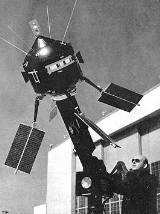
Ariel 3
Encyclopedia
Ariel 3 was the first artificial satellite
designed and constructed in the United Kingdom
. it was launched from Vandenberg Air Force Base
on May 5, 1967 aboard a Scout
launch vehicle. Ariel 3 had an orbital period of approximately 95 minutes, with an apogee of 608 km and a perigee
of 497 km. It initially spun at 31 rpm for stability, though by the time the Ariel 3 deorbited
, it had slowed to a rate of about 1 rpm.
Ariel 3 carried five experiments. The experiments measured properties of the Thermosphere
as well as detected "terrestrial radio noise" from thunderstorms and measured large-scale galactic radio frequency
noise. Experimental data was recorded on an onboard tape recorder, then later transmitted to waiting observers on Earth. Ariel 3 was also fitted with a series of mirrors to allow easy observation of the satellite. On October 24, 1967 the tape recorder abroad Ariel 3 began to malfunction. This restricted observation to real-time operation only. Ariel 3 suffered from a significant power failure in December 1968, restricting the satellite's operation to daylight hours only. The satellite was completely shut down in September 1969. Its orbit decayed steadily until on December 14, 1970 when Ariel 3 re-entered Earth's atmosphere.
Satellite
In the context of spaceflight, a satellite is an object which has been placed into orbit by human endeavour. Such objects are sometimes called artificial satellites to distinguish them from natural satellites such as the Moon....
designed and constructed in the United Kingdom
United Kingdom
The United Kingdom of Great Britain and Northern IrelandIn the United Kingdom and Dependencies, other languages have been officially recognised as legitimate autochthonous languages under the European Charter for Regional or Minority Languages...
. it was launched from Vandenberg Air Force Base
Vandenberg Air Force Base
Vandenberg Air Force Base is a United States Air Force Base, located approximately northwest of Lompoc, California. It is under the jurisdiction of the 30th Space Wing, Air Force Space Command ....
on May 5, 1967 aboard a Scout
Scout (rocket)
The Scout family of rockets were launch vehicles designed to place small satellites into orbit around the Earth. The Scout multistage rocket was the first orbital launch vehicle to be entirely composed of solid fuel stages....
launch vehicle. Ariel 3 had an orbital period of approximately 95 minutes, with an apogee of 608 km and a perigee
Perigee
Perigee is the point at which an object makes its closest approach to the Earth.. Often the term is used in a broader sense to define the point in an orbit where the orbiting body is closest to the body it orbits. The opposite is the apogee, the farthest or highest point.The Greek prefix "peri"...
of 497 km. It initially spun at 31 rpm for stability, though by the time the Ariel 3 deorbited
Orbit
In physics, an orbit is the gravitationally curved path of an object around a point in space, for example the orbit of a planet around the center of a star system, such as the Solar System...
, it had slowed to a rate of about 1 rpm.
Ariel 3 carried five experiments. The experiments measured properties of the Thermosphere
Thermosphere
The thermosphere is the biggest of all the layers of the Earth's atmosphere directly above the mesosphere and directly below the exosphere. Within this layer, ultraviolet radiation causes ionization. The International Space Station has a stable orbit within the middle of the thermosphere, between...
as well as detected "terrestrial radio noise" from thunderstorms and measured large-scale galactic radio frequency
Radio frequency
Radio frequency is a rate of oscillation in the range of about 3 kHz to 300 GHz, which corresponds to the frequency of radio waves, and the alternating currents which carry radio signals...
noise. Experimental data was recorded on an onboard tape recorder, then later transmitted to waiting observers on Earth. Ariel 3 was also fitted with a series of mirrors to allow easy observation of the satellite. On October 24, 1967 the tape recorder abroad Ariel 3 began to malfunction. This restricted observation to real-time operation only. Ariel 3 suffered from a significant power failure in December 1968, restricting the satellite's operation to daylight hours only. The satellite was completely shut down in September 1969. Its orbit decayed steadily until on December 14, 1970 when Ariel 3 re-entered Earth's atmosphere.
External links
- National Space Science Data Center entry for Ariel 3
- On This Day' for May 5, 1967 BBC NewsBBC NewsBBC News is the department of the British Broadcasting Corporation responsible for the gathering and broadcasting of news and current affairs. The department is the world's largest broadcast news organisation and generates about 120 hours of radio and television output each day, as well as online...

